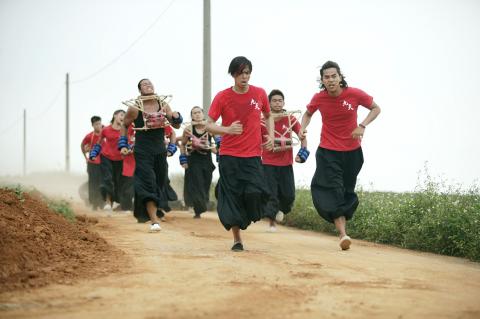Seasoned television director Fung Kai’s (馮凱) Din Tao: Leader of the Parade (陣頭) is edifying for those not familiar with dintao, a type of traditional temple performance troupe. For everyone else, the film is an overly long formulaic exercise in banality.
Performer Allen Ko (柯有倫) plays A-tai, a young man who dreams about becoming a rocker in the US. He quits school in Taipei and returns to his Taichung hometown before following his heart’s desire.
A-tai has never been on good terms with his father, Uncle Da (Chen Po-cheng, better know as A-hsi, 阿西), who runs a dintao troupe. The father and son never make an effort to understand one another, and quarrel each time they meet.

Photo Courtesy of IFILM
But Uncle Da has other things to worry about. While his company struggles to make ends meet, long-standing rival Wu Cheng (Liao Chun, 廖峻) and his troupe meet with success and popularity.
Irked by Wu’s arrogance, A-tai decides to take the troupe’s demoralized members on a countrywide walk in search of inspiration to revamp the traditional folk art form.
The movie was inspired by the Jyou-Tian Folk Drum and Arts Group (九天民俗技藝團). Founded in 1995 by drummer Shue Chen-rong (許振榮), the Taichung-based troupe is credited with updating folk drumming, acrobatics and traditional dances for contemporary audiences and introducing the performances to international audiences by attending art festivals abroad. The troupe’s last sojourn was a seven-day, 250km-long ultra marathon across the Sahara Desert in Egypt in October, completed while its members carried a 17kg statue of the deity Nezha (哪吒).

Photo Courtesy of IFILM
The movie has a certain degree of authenticity in its depiction of dintao as an extended family in which the troupe’s leader is more like a father figure to the group’s young members, most of whom are dropouts. It also fares well in the acting department, anchored by veteran actors A-hsi, Liao Chun and Samantha Ko (柯淑勤). Pop idol Alien Huang, better known as Hsiao-kuei (小鬼), deserves special mention for his dintao performances. Yet the movie is little more than a glorified television drama, replete with cliches, stereotypical characters and an uneven narrative.
As Taiwanese grassroots culture is a mainstay of local productions of late, movies like Din Tao: Leader of the Parade have come one after another, following what is believed to be a winning formula that blends traditional practices with modern elements. However, without a good story line and emotional depth to sustain it, the enthusiasm for traditional cultural doesn’t last the distance.

Photo Courtesy of IFILM

This month the government ordered a one-year block of Xiaohongshu (小紅書) or Rednote, a Chinese social media platform with more than 3 million users in Taiwan. The government pointed to widespread fraud activity on the platform, along with cybersecurity failures. Officials said that they had reached out to the company and asked it to change. However, they received no response. The pro-China parties, the Chinese Nationalist Party (KMT) and Taiwan People’s Party (TPP), immediately swung into action, denouncing the ban as an attack on free speech. This “free speech” claim was then echoed by the People’s Republic of China (PRC),

Exceptions to the rule are sometimes revealing. For a brief few years, there was an emerging ideological split between the Democratic Progressive Party (DPP) and Chinese Nationalist Party (KMT) that appeared to be pushing the DPP in a direction that would be considered more liberal, and the KMT more conservative. In the previous column, “The KMT-DPP’s bureaucrat-led developmental state” (Dec. 11, page 12), we examined how Taiwan’s democratic system developed, and how both the two main parties largely accepted a similar consensus on how Taiwan should be run domestically and did not split along the left-right lines more familiar in

Specialty sandwiches loaded with the contents of an entire charcuterie board, overflowing with sauces, creams and all manner of creative add-ons, is perhaps one of the biggest global food trends of this year. From London to New York, lines form down the block for mortadella, burrata, pistachio and more stuffed between slices of fresh sourdough, rye or focaccia. To try the trend in Taipei, Munchies Mafia is for sure the spot — could this be the best sandwich in town? Carlos from Spain and Sergio from Mexico opened this spot just seven months ago. The two met working in the

Many people in Taiwan first learned about universal basic income (UBI) — the idea that the government should provide regular, no-strings-attached payments to each citizen — in 2019. While seeking the Democratic nomination for the 2020 US presidential election, Andrew Yang, a politician of Taiwanese descent, said that, if elected, he’d institute a UBI of US$1,000 per month to “get the economic boot off of people’s throats, allowing them to lift their heads up, breathe, and get excited for the future.” His campaign petered out, but the concept of UBI hasn’t gone away. Throughout the industrialized world, there are fears that